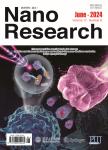Porous-hollow nanorods constructed from alternate intercalation of carbon and MoS2 monolayers for lithium and sodium storage
作者机构:State Key Lab of Crystal MaterialsShandong UniversityJinan 250100China School of PhysicsShandong UniversityJinan 250100China Tianjin Key Laboratory of Advanced Functional Porous MaterialsInstitute for New Energy Materials and Low-Carbon TechnologiesSchool of Materials Science and EngineeringTianjin University of TechnologyTianjin 300384China Key Laboratory for Special Functional Aggregated Materials of Education MinistrySchool of Chemistry and Chemical Engineering Shandong UniversityJinan 250100China School of Materials Science and Engineering Georgia Institute of TechnologyAtlantaGeorgia 30332USA
出 版 物:《Nano Research》 (纳米研究(英文版))
年 卷 期:2019年第12卷第8期
页 面:1912-1920页
核心收录:
学科分类:0808[工学-电气工程] 07[理学] 0809[工学-电子科学与技术(可授工学、理学学位)] 0805[工学-材料科学与工程(可授工学、理学学位)] 0702[理学-物理学]
基 金:supported by the National Natural Science Foundation of China (No.51872172) Natural Science Foundation of Shandong Province (Nos.ZR2018MEM010 and ZR2019MEM021) Major Research and Development Program for Public Welfare in Shandong (No.2018GGX102021) Young Scholars Program of Shandong University.
主 题:lithium/sodium ion batteries porous-hollow nanorods expanded interlayer spacing alternate intercalation ultrathin nanosheets
摘 要:Weak ion diffusion and electron transport due to limited interlayer spacing and poor electrical conductivity have been identified as critical roadbacks for fast and abundant energy storage of both MoS2-based lithium ion batteries (LIBs) and sodium ion batteries (SIBs). In this work, MoS2 porous-hollow nanorods (MoS2/m-C800) have been designed and synthesized via an annealing-followed chemistry-intercalated strategy to solve the two issues. They are uniformly assembled from ultrathin MoS2 nanosheets, deviated to the rod-axis direction, with expanded interlayer spacing due to alternate intercalation of N-doped carbon monolayers between the adjacent MoS2 monolayers. Electrochemical studies of the MoS2/m-C800 sample, as an anode of LIBs, demonstrate that the superstructure can deliver a reversible discharge capacity of 1,170 mAh·g^-1 after 100 cycles at 0.2 A·g^-1 and maintain a reversible capacity of 951 mAh·g^-1 at 1.25 A·g^-1 after 350 cycles. While for SIBs, the superstructure also delivers a reversible discharge capacity of 350 mAh·g^-1 at 0.5 A-g-1 after 500 cycles and exhibits superior rate capacity of 238 mAh·g^-1 at 15 A·g^-1 .The excellent electrochemical performance is closely related with the hierarchical superstructures, including expanded interlayer spacing, alternate intercalation of carbon monolayers and mesoporous feature, which effectively reduce ion diffusion barrier, shorten ion diffusion paths and improve electrical conductivity.



